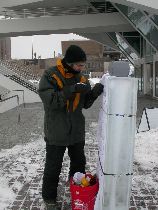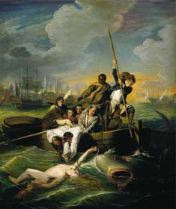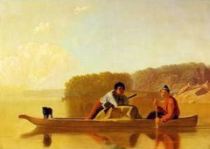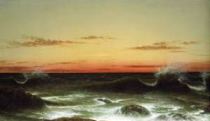 I left Milwaukee and came home to Philadelphia and it looked pretty much like Milwaukee.
I left Milwaukee and came home to Philadelphia and it looked pretty much like Milwaukee.
(image is the 12-inch snow blanket in Milwaukee last Saturday.)
Anyway, I wanted to yak a little more about the past — like the past of American art in a show I saw at MAM. But before I do, I’ll make this right turn detour to mention a Chicago artist and blogger, Cynthia King, whose Fresh Paint blog is a snappy, opinionated site about art in Chicago…and Milwaukee! Yes, Cynthia has been all over the Calatrava and MAM and is also an enthusiast. Read her posts here and here. She’s also been to Wausau WI (how many can say that!!) and covers the new Patrick Dougherty sculpture project there.

Because the world is small and artists get around, I’ll mention that the globe-trotting Dougherty did a project at Swarthmore a couple years ago. And talk about chutzpah (see Libby’s post on Matthew Ronay for more on that), when you go to Dougherty’s website and click on installations to see where he’s been, a map of the world comes up and you’re told to click on any continent you’re curious about to see what he’s done there! …The Dougherty global cartel.)
I’ve bookmarked Fresh Paint and encourage you to check it out. (image is Milwaukee artist Joel Skaja working on an ice scupture for the city’s second annual ice sculpture competition. Skaja told me his piece, which would be a totem pole of Milwaukee logos, was one of 18 entries in the contest which included a $750 prize for the winner.)
Meanwhile back to the past

Right now, the Milwaukee Art Museum is hosting a travelling exhibit of early American art (1770-1920)from the Detroit Institute of the Arts. Having just recently experienced the early American art at PAFA, I felt I could compare. The DIA exhibit had outstanding works by famous early artists: five John Singleton Copleys; a couple sublime Thomas Coles and Frederick Churches; a number of Martin Johnson Heades; and a George Caleb Bingham. (Shown right is Copley’s “Watson and the Shark,” 1782, one of three versions of a painting commissioned by Brook Watson to commemorate an event that happened to him while swimming in the Havana harbor. Watson went on to be a rich merchant in London.)
After that early period showing people, the sublime mountains and vocanos and nature in general, the show got a little weaker with only a few works by major artists like Thomas Eakins, Mary Cassatt and John Singer Sargent and not the best works by these artists. Moving into the 20th Century, the Ash Can school (again, not represented by its best works) was downright depressing. And American Impressionism in this show seemed silly and jejeune. ( Left is Bingham‘s “The Trapper’s Return, 1851. On the far left in the boat is a bear cub.)

The show of 90 paintings and sculptures was pretty crowded with viewers the snowy Friday that Cate and I saw it and I have to believe the non-threatening historical exhibition is a draw. There’s nothing controversial about a history lesson. It just is.
The best works in the exhibit were Copley’s “Watson and the Shark” (above) and Heade‘s “Hummingbirds and Orchids” (1880s). Both works had drama, delicious color, sublime nature and that anthropomorphozed animal thing going on, making them instant stand-outs. (bottom image is Heade‘s “Seascape Sunset” 1861, with some frozen waves sticking up over a cherry red horizon line. The wall plaque said it showed Heade’s worries about the impending Civil War.)
I believe the PAFA collection goes deeper into early American art than this (albeit circumscribed) travelling exhibit does. But given the drawing power of the Detroit exhibit, I have to believe PAFA, if it markets itself smartly, will do well with its new reinstallation of its strong early American art collection.
I’m thinking about art museums in general and how they serve the public and will get it together in another post.









